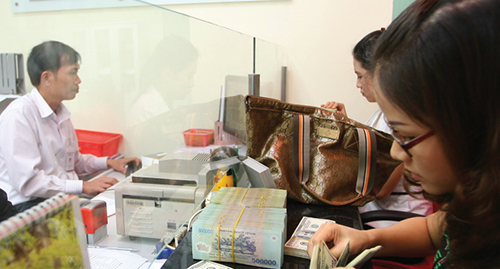SBV tweaks exchange rate to ease tensions

The State Bank (SBV) increased the exchange rate by 1 per cent for the first time since December, 2011 to VND21,036 per USD from VND20,828, effective from June 28, according to a statement on the central bank’s website.
This adjustment is intended to better reflect foreign currency supply and demand, thus stabilising the foreign exchange market. The SBV would take all necessary measures to guarantee exchange rate stability, said the statement.
The adjustment is also considered to be in line with the sharp depreciation in the currencies of emerging economies against the US dollar.
“After keeping the reference rate constant at 20,828 for 18 months, this devaluation is overdue and widely expected by investors,” said Alan Pham, chief economist at VinaCapital, a leading fund management company in Vietnam.
“The State Bank’s move was actually reactive, following market developments instead of leading them, because market rates had already reached 21,200 in the days before,” he said.
Pham Hong Hai, a managing director at HSBC, also said markets had been expecting the adjustment for several weeks when foreign currency demand and supply began showing signs of tension with higher demand and lower supply. In addition, he added, the exchange rate had been fixed for a long time which had raised expectations for an exchange rate adjustment.
Pham agreed with the policy move citing the support it gives to export companies. Exports are an important part of the country’s gross domestic product (GDP), and would help boost its growth, which was weak at 4.9 per cent in the first half of this year.
“We do not think this step will lead to a weakening of the Vietnam dong. The State Bank’s official reserves are at $30 billion and it can intervene in the forex market to support Vietnam’s currency. The overall balance of payments is expected to be in surplus. Other capital inflows like remittances, FDI disbursements and ODA loans will be stable and keep a positive current account balance as well,” Pham added.
Banking expert Nguyen Tri Hieu, however, held a different view. He argued that the depreciation of the Vietnam dong might be the State Bank’s own orientation rather than the result of mounting pressure from the market, “because imports have not put much pressure on the economy so far this year.”
Pham of VinaCapital noted that the change at 1 per cent was small and it was well within the 2-3 per cent limit of depreciation to which the State Bank is committed. “The SBV is likely to devalue the dong by 1 per cent in the fourth quarter of this year given that it still has room to do so.”
What the stars mean:
★ Poor ★ ★ Promising ★★★ Good ★★★★ Very good ★★★★★ Exceptional
Latest News
More News
- The promotion of ESG via banking (November 21, 2024 | 09:32)
- Standard Chartered committed to Vietnam’s financial success (November 21, 2024 | 09:24)
- Full ESG adoption the priority for Agribank (November 21, 2024 | 09:07)
- Banks entice youth with tech advances (November 21, 2024 | 08:00)
- Banks shaping the future as business advisors (November 20, 2024 | 21:00)
- ESG represents a shift towards sustainability for banks (November 20, 2024 | 13:00)
- GGGI supports Vietcombank’s debut of $80 million green bonds (November 20, 2024 | 11:20)
- SHB and the ESG journey: creating social value in every step (November 19, 2024 | 15:00)
- Banking sector contributes to ESG, green growth, and sustainable development (November 19, 2024 | 14:42)
- ESG implementation in banking: from awareness to action (November 19, 2024 | 12:08)

















 Mobile Version
Mobile Version